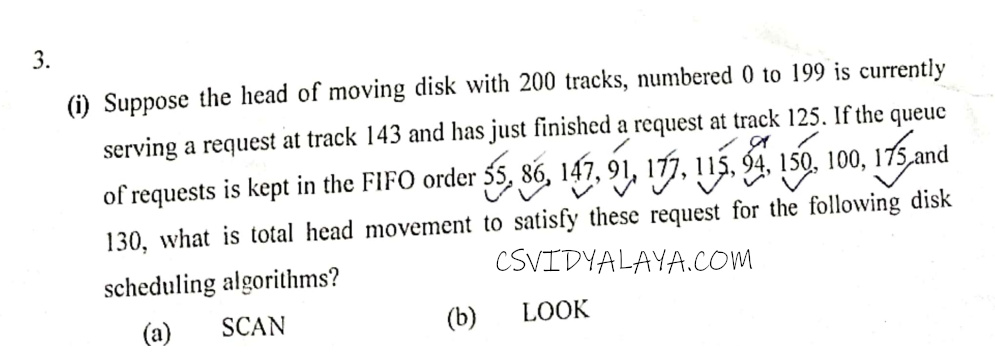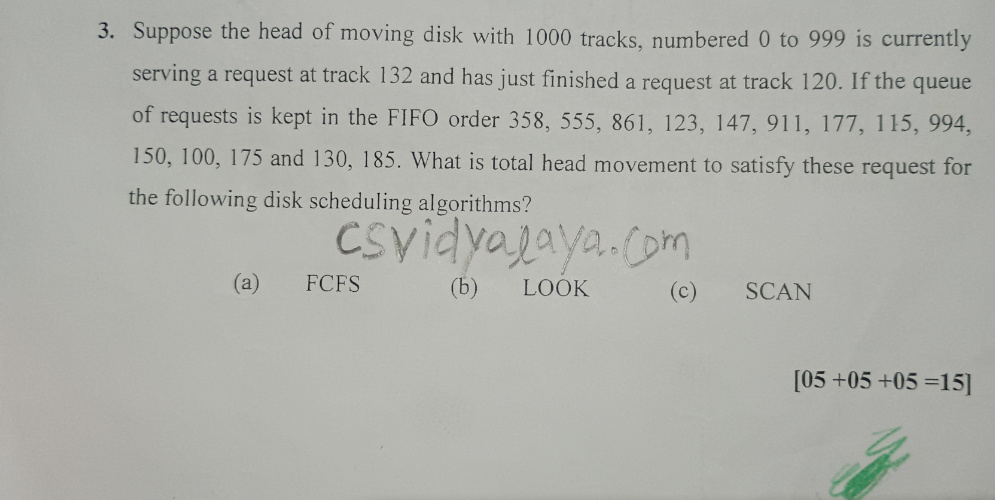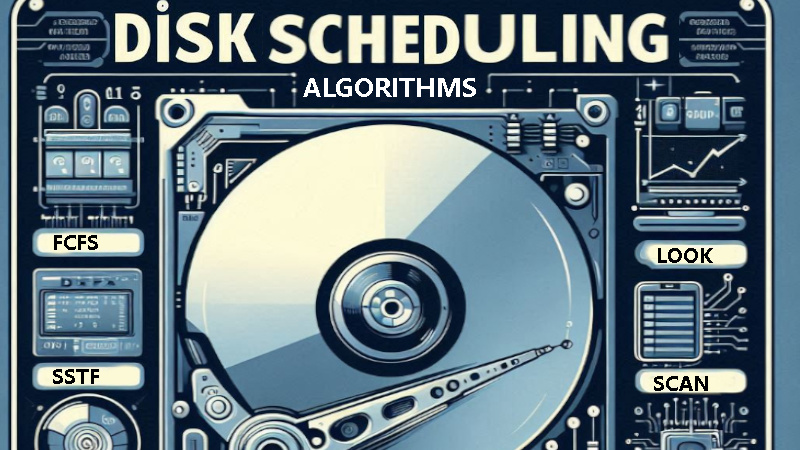Disk Scheduling is a key concept in operating systems , and if you're preparing for exams or interviews, mastering this topic can seriously boost your knowledge level. Whether you’re a computer science student, an OS enthusiast, or someone tackling semester exams—this post is your go-to guide!
We’ve compiled 11 solved disk scheduling problems that cover various algorithms(for example FCFS, SSTF, LOOK, SCAN, C-SCAN), plus Previous Year Questions (PYQs) with detailed step-by-step solutions. You’ll learn, practice, and clear your doubts in one place. Let’s dive in!
few days ago, I’ve shared solved questions and previous year questions (PYQs) for CPU Scheduling, Banker’s Algorithm, and The Buddy System.
Popular Disk Scheduling Algorithms :
- FCFS (First Come First Serve)
- SSTF (Shortest Seek Time First)
- SCAN (Elevator Algorithm)
- C-SCAN (Circular SCAN)
- LOOK and C-LOOK
Question 1: Suppose the head of moving disk with 200 tracks, numbered 0 to 199 is currently serving a request at track 132 and has just finished a request at track 120. If the queue of requests is kept in the FIFO order 38, 55, 86, 123, 147, 91, 177, 115, 94, 150, 100, 175 and 130, 185. What is total head movement to satisfy these request for the following disk scheduling algorithms? (a) FCFS (b) LOOK
Answer :
(A) FCFS :
Step-by-step movement:
132 -> 38 -> 55 -> 86 -> 123 -> 147 -> 91 -> 177 -> 115 ->
94 -> 150 -> 100 -> 175 -> 130 -> 185
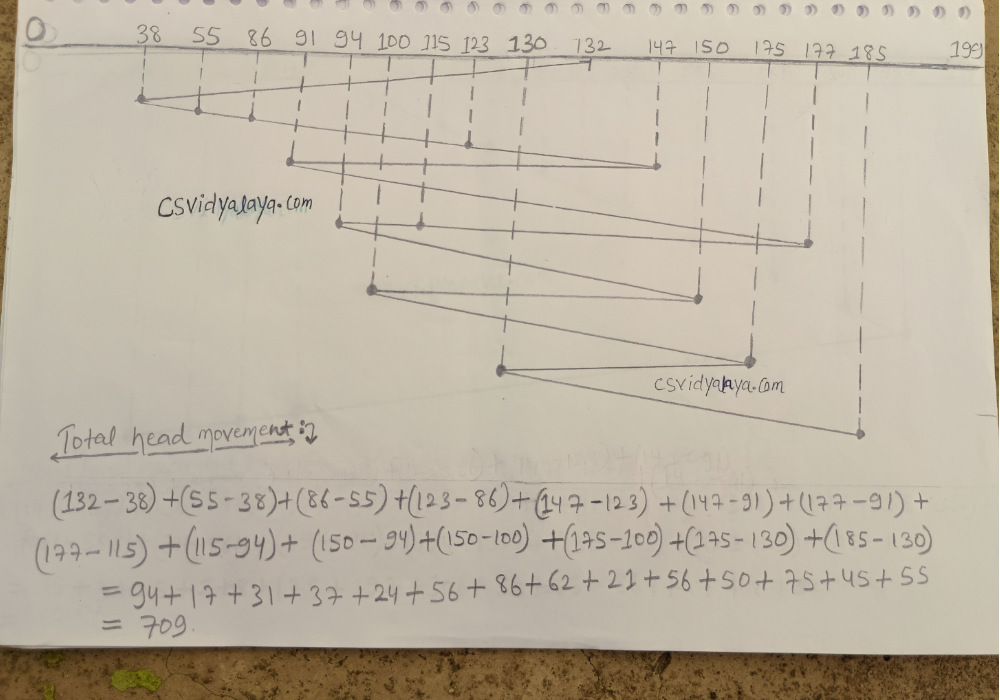
Total head Movement :
(132 - 138 ) + (55 - 38) + (86 - 55) + (123 - 86 ) + (147 -
123) + (147 - 91) + (177 - 91) + (177 - 115) + (115 - 94) +
(150 - 94) + (150 - 100) + (175 - 100) + (175 - 130) + (185
- 130)
= 709
(B) LOOK :
Step-by-step movement:
132 -> 147 -> 150 -> 175 -> 177 -> 185 -> 130 -> 123 -> 115
-> 100 -> 94 -> 91 -> 86 -> 55 -> 38
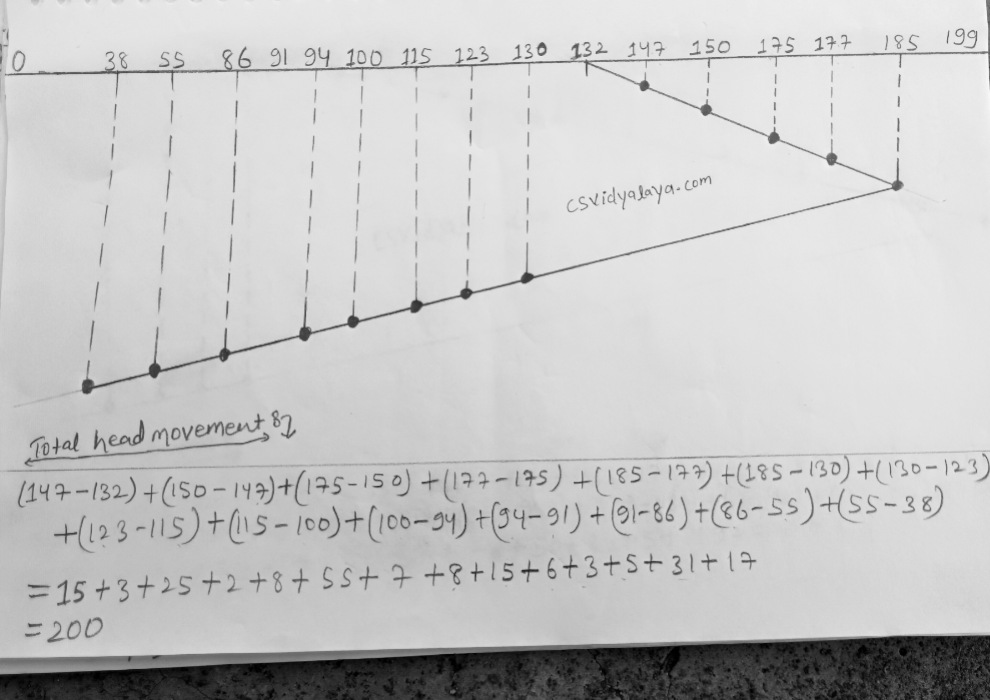
Total head Movement :
(147 - 132) + (150 - 147) + (175 - 150) + (177 - 175) + (185
- 177) + (185 - 130) + (130 - 123) + (123 - 115) + (115 -
100) + (100 - 94) + (94 - 91) + (91 - 86) + (86 - 55) + (55
- 38)
= 200
Question 2: Suppose the head of moving disk with 200 tracks, numbered 0 to 199 is currently serving a request at track 143 and has just finished a request at track 125. If the queue of requests is kept in the FIFO order 55, 86, 147, 91, 177, 115,94, 150, 100, 175 and 130, what is total head movement to satisfy these request for the following disk scheduling algorithms? (a) SCAN (b) LOOK
solution :
(A) SCAN :
Step-by-step movement:
143 -> 147 -> 150 -> 175 -> 177 -> 199 -> 130 -> 115 -> 100
-> 94 -> 91 -> 86 -> 55

total head movement :-
(147 - 143) + (150 - 147) + (175 - 150) + (177 - 175) + (199
- 177) + (199 - 130) + (130 - 115) + (115 - 100) + (100 -
94) + (94 - 91) + (91 - 86) + (86 - 55)
= 200
(B) LOOK :
Step-by-step movement:
143 -> 147 -> 150 -> 175 -> 177 -> 130 -> 115 -> 100 -> 94
-> 91 -> 86 -> 55
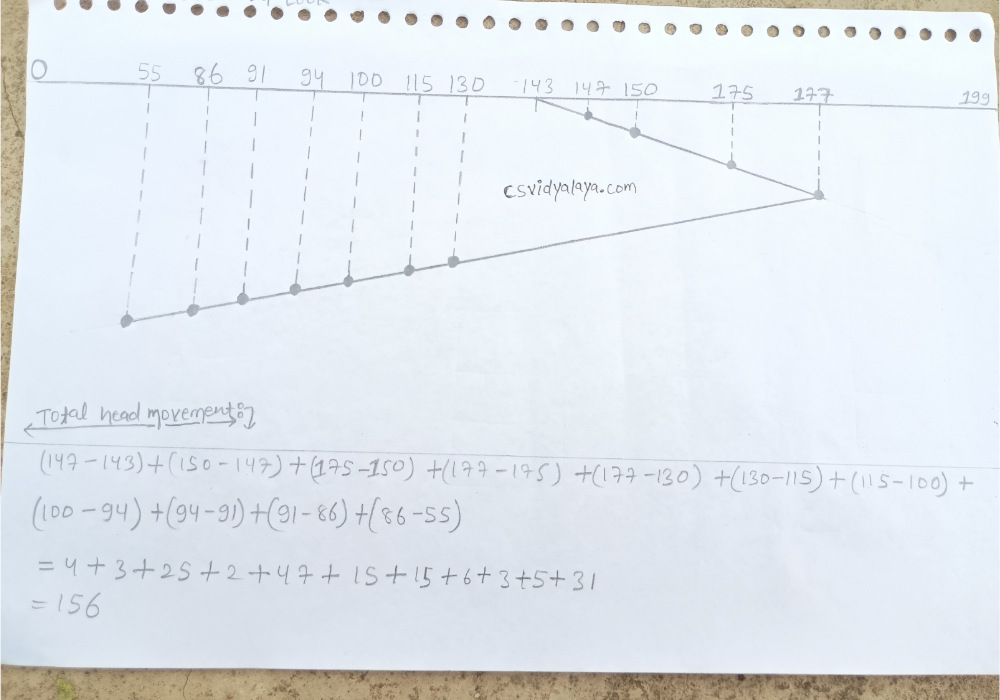
total head movement :-
(147 - 143) + (150 - 147) + (175 - 150) + (177 - 175) + (177
- 130) + (130 - 115) + (115 - 100) + (100 - 94) + (94 - 91)
+ (91 - 86) + (86 - 55)
= 156
Question 3: Suppose the head of moving disk with 1000 tracks, numbered 0 to 999 is currently serving a request at track 132 and has just finished a request at track 120. If the queue of requests is kept in the FIFO order 358, 555, 861, 123, 147, 911,177, 115, 994, 150 , 100, 175, and 130, 185 what is total head movement to satisfy these request for the following disk scheduling algorithms? (a) FCFS (b)LOOK (C) SCAN
solution : (a) FCFS
Step-by-step movement:
132 -> 358 -> 555 -> 861 -> 123 -> 147 -> 911 -> 177 -> 115
-> 994 -> 150 -> 100 -> 175 -> 130 -> 185
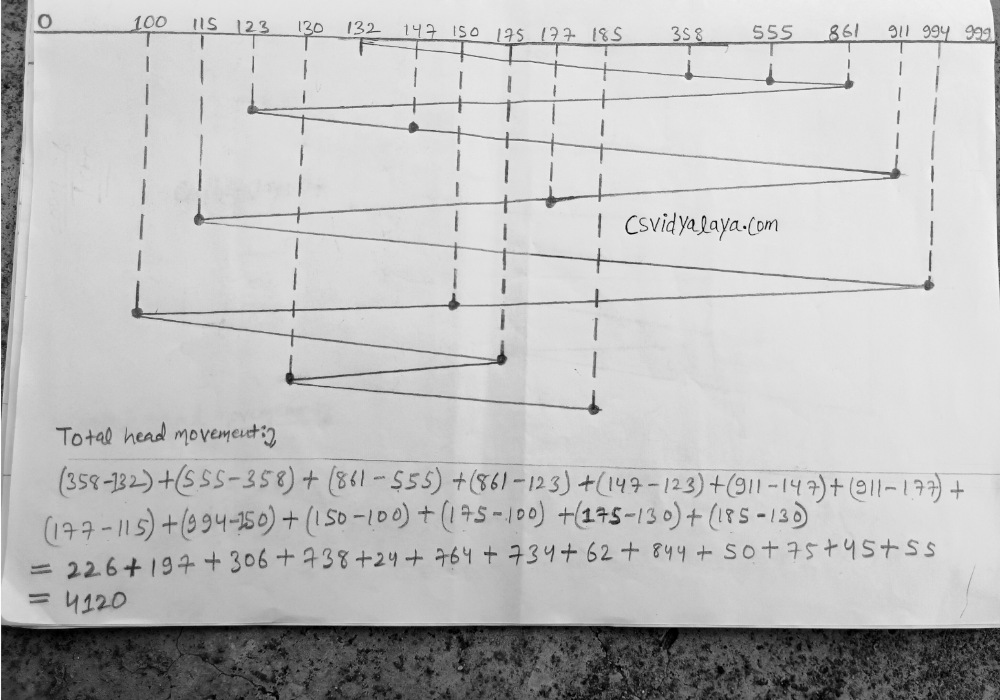
total head movement :-
(358 - 132) + (555 - 358) + (861 - 555) + (861 - 123) + (147
- 123) + (911 - 147) + (911 - 177) + (177 - 115) + (994 -
150) + (150 - 100) + (175 - 100) + (175 - 130) + (185 - 130)
= 4120
(B) LOOK
Step-by-step movement:
132 -> 147 -> 150 -> 175 -> 177 -> 185 -> 358 -> 555 -> 861
-> 911 -> 994 -> 130 -> 123 -> 115 -> 100

total head movement :-
(147 - 132) + (150 - 147) + (175 - 150) + (177 - 175) + (185
- 177) + (358 - 185) + (555 - 358) + (861 - 555) + (911 -
861) + (994 - 911) + (994 - 130) + (130 - 123) + (123 - 115)
+ (115 - 100)
= 1756
(C) SCAN :
Step-by-step movement:
Step-by-step movement:
132 -> 147 -> 150 -> 175 -> 177 -> 185 -> 358 -> 555 -> 861
-> 911 -> 994 -> 999 -> 130 -> 123 -> 115 -> 100
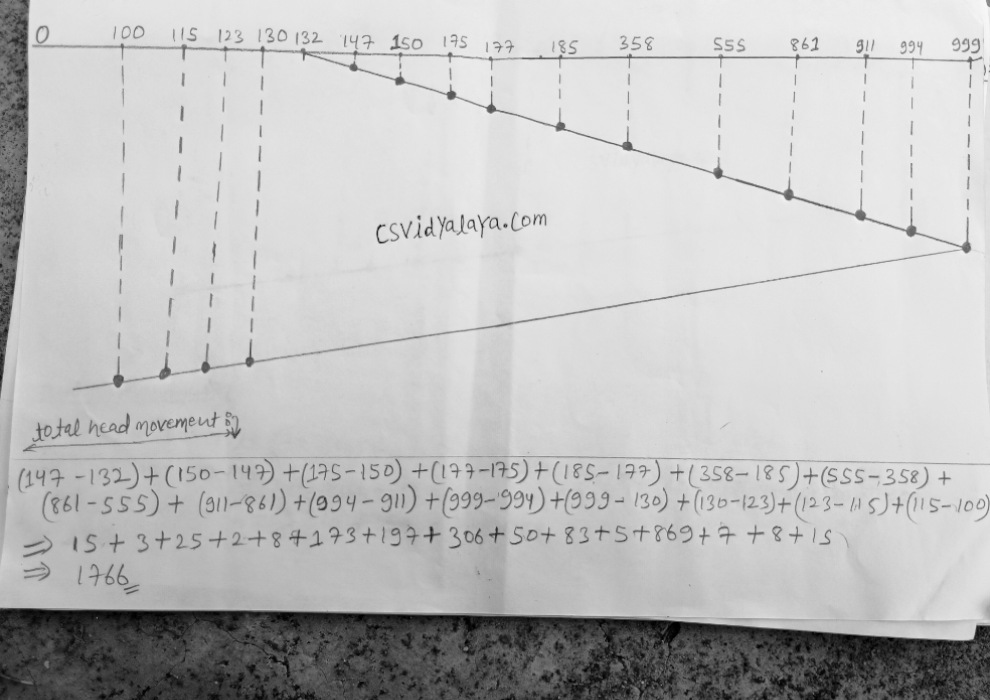
total head movement :-
(147 - 132) + (150 - 147) + (175 - 150) + (177 - 175) + (185
- 177) + (358 - 185) + (555 - 358) + (861 - 555) + (911 -
861) + (994 - 911) + (999 - 994) + (999 - 130) + (130 - 123)
+ (123 - 115) + (115 -100)
= 1766
Previous year Question
